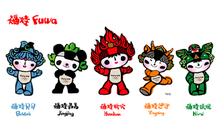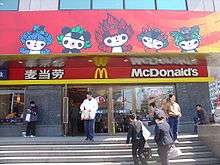Fuwa
| Fuwa | |||||||||||
 The Fuwa | |||||||||||
| Chinese | 福娃 | ||||||||||
|---|---|---|---|---|---|---|---|---|---|---|---|
| Literal meaning | dolls of blessing | ||||||||||
| |||||||||||
| Part of a series on |
|
|
The Fuwa (Chinese: 福娃; pinyin: Fúwá; literally "good-luck dolls", also known as "Friendlies") were the mascots of the 2008 Summer Olympics in Beijing. The designs were created by Han Meilin, a famous Chinese artist.[1] The designs were publicly announced by the National Society of Chinese Classic Literature Studies on 11 November 2005 at an event marking the 1000th day before the opening of the games.
There are five Fuwas: Beibei, Jingjing, Huanhuan, Yingying and Nini. Together, the names form the sentence "北京欢迎你", or "Beijing huanying ni," which means "Beijing welcomes you". Originally named 'The Friendlies', they were promoted as 'Fuwa' when concerns arose that the name could be misinterpreted.[2][3]
While originally given artistic licence in his commission, Han Meilin was subsequently requested by officials to include various Chinese designs and fauna in the Fuwa. Han Meilin drew 1,000 models of possible Fuwa (including a dragon and an anthropomorphic drum) before settling on the five characters. He has since disowned the Fuwa and did not include them in his museum.[4]
Mascots
| Name | Beibei (贝贝) | Jingjing (晶晶) | Huanhuan (欢欢) | Yingying (迎迎) | Nini (妮妮) |
|---|---|---|---|---|---|
| Gender | Female | Male | Male | Male | Female |
| Representing Continent | Europe | Africa | America | Asia | Oceania |
| Picture | |||||
| Cultural inspiration |
Traditional Chinese New Year decorative picture of lotus and fish; fish design from Neolithic artifacts. |
Giant panda; Song Dynasty lotus-shaped porcelain. |
Olympic flame; Fire design from the Mogao Grottoes. |
Tibetan antelope, Tibetan and Xinjiang ethnic costumes. |
Swift; Beijing's sand martin kite. |
| Olympic Ring | Blue | Black | Red | Yellow | Green |
| Represented Element[5] | Sea | Forest | Fire | Earth | Sky |
| Actual Fengshui Element[6] | Water | Wood | Fire | Earth | Metal |
| Personality | Friendly, leader | Honest, optimistic | Extrovert, enthusiastic | Lively, independent | Just, kind |
| Represented ideal | Prosperity | Happiness | Passion | Health | Good fortune |
| Represented sport | aquatic sports | weightlifting, judo, etc. | ball sports/racquet sports | track and field | gymnastics |
| Notes | In traditional Chinese culture, the fish represents prosperity, as the character for fish (鱼 / 魚) sounds the same as that for surplus (余 / 餘). The "carp leaping over the dragon gate" is a traditional allegory of following one's dreams and achieving them. The pattern from Beibei's headgear comes from artifacts unearthed at Banpo, site of a Neolithic village of the Yangshao culture. | As an endangered species, the panda is both a national symbol of China and an international symbol of environmentalism. Jingjing's forest origins also symbolize the harmonious coexistence of humankind and nature. | Huanhuan represents the passion of sports, the Olympic spirit of "faster, higher, stronger", and the passion of the Beijing Olympics. Huanhuan's headgear comes from a fire design in the Mogao Caves, the best known of the Chinese Buddhist grottoes. | The Tibetan antelope is an endangered species native to the Tibetan Plateau, known for its swiftness. Yingying's headgear incorporates elements of Tibetan and Xinjiang ethnic costumes. | The swallow is a messenger of spring and happiness in Chinese culture, and is seen as a symbol of good fortune. The Chinese character for swallow (燕) is also used in Yanjing (燕京), an old name for Beijing; thus the swallow alludes to Beijing. Nini's headgear uses the design of Beijing's sand martin kites, which are colourful cross-shaped kites modeled after swallows. |
Media
TV series
A 100-episode Olympic-themed cartoon series featuring the Fuwa was released in China, primarily on BTV (Beijing's municipal television network), on 8 August 2007. Titled The Olympic Adventures of Fuwa (Chinese: 福娃奥运漫游记; pinyin: Fúwá Àoyùn Mànyóujì), it was jointly produced by BTV and Kaku Cartoon.[7]
There are also two other cartoons created by CCTV.
Video game
The characters made a cameo appearance in the Mario & Sonic at the Olympic Games video game.
China Environmental Awareness Programme
The China Environmental Awareness Programme program, started in 2001, has the Fuwa raising public environmental awareness by spreading clean, green messages.[8]
Fuwa theater show
A large-scale fairy-tale drama entitled Friendlies (or Fuwa) has been directed by Beijing Children's Art Theater Cooperative to promote the five mascots of the 2008 Beijing Olympics. As ambassadors of peace, the Fuwa will make a world-tour, visiting all seven continents.[9]
Parodies
Groups seeking to raise political issues in tandem with China's hosting of the Olympic Games have used the Fuwa or have created similar mascots.
- Nu Wa, a monkey with a red bandana, was created by Amnesty International. Nu Wa means "angry young boy".[10]
- Play Fair 2008, a campaign organised by the Clean Clothes Campaign (CCC), the International Trade Union Confederation (ITUC), and the International Textile, Garment and Leather Workers' Federation (ITGLWF) to raise awareness for the rights of workers involved in the sporting goods industries, have used the Fuwa.[11]
- Gengen Genocide, a brown and yellow character wearing a gun and a fuel pump nozzle head-dress that forms a skull and crossbones, was developed by a group seeking to raise attention to the People's Republic of China's involvement in Darfur. Gengen's name is derived from the term genocide.[12]
In addition, Beijing residents have allegedly created their own Fuwa set consisting of a duck, a dragonfly and a taxi. Collectively their names—"Ya", "Ting", "De"—spell out "bastard" in Beijing slang.[4] (Note that among friends, "ni ya ting de", which means "you bastard", is a common term of endearment but is considered crude by many.)
Superstitions
Wuwa

In the months leading up to the Olympics, coincidental similarities between the characters and several events became were noted on the internet blogs under titles such as "Curse of the fuwa".[13][14] Some Chinese have taken to calling the characters "Wuwa" (witch dolls).[4] Online criticism of the dolls has frequently been censored.[15]
- Nini, a swallow thought to be a kite, was blamed for the "kite city" of Weifang T195 train accident. Nini was also believed to be a locust, and associated with a locust plague that infested Inner Mongolia in June 2008.[4]
- Yingying, a Tibetan antelope, for the 2008 Tibetan unrest.
- Huanhuan, representing the Olympic flame, for the Summer Olympics torch relay protests.
- Jingjing, a panda, for the Sichuan earthquake. The epicenter of the earthquake is very close to the Wolong Nature Reserve.
- Beibei, a Chinese sturgeon of water/sea element, for the 2008 South China floods.
Killer barracuda
The Fuwa Beibei is represented by a Chinese sturgeon.[16] Five sturgeons were presented by China to Hong Kong[17] with each fish representing an Olympic ring, in addition to the "motherland's love" for the Hong Kong Special Administrative Region.[18] The smallest of the five sturgeon (1.1 meters) was bitten by one of the barracudas housed in the same aquarium, and died the day after being publicly released into the city's theme park aquarium Ocean Park.[17][19] Necropsy showed that the bite was not aggressive, but a reflex action from contact between the fish.[20] Ocean Park said no one is at fault since in the almost 10 years the eight barracudas had been with the park, they had never showed any signs of aggression.[20] Feng shui experts were divided about the death of the sturgeon, there were some that said this event may imply misfortune, and there were some that said 'the public did not need to worry too much because all fish die' and 'Can I say it's a bad omen for the Olympic Games if, for example, my five tadpoles—which I say represent the Olympic rings—die at home?'.[21] Beijing's central government replaced the one that died with five more sturgeons.[22]
Han Meilin
The 72-year-old artist Han Meilin suffered two heart attacks while designing the Fuwa.[4]
See also
- Fu Niu Lele, mascot of the 2008 Summer Paralympics in Beijing
References
- ↑ CCTV - retrieved 11 September 2007
- ↑ "Mascot renamed Fuwa in English". Chinadaily.com.cn. 17 October 2006. Retrieved 2012-07-05.
- ↑ F, D (29 November 2006). "Not so friendly anymore". Time Out (November 2006): 6.
- 1 2 3 4 5 The Wall Street Journal "." Here's Another Olympic Sport:Skewering the Mascots Retrieved on 2008-07-24.
- ↑ Beijing official website.
- ↑ Feng Shui FAQs Retrieved on 2008-07-24.
- ↑ Wang Wenjie (31 October 2007). "Adventuring With the Mascots". Beijing Review. Retrieved 2008-06-16.
- ↑ Five FuWa to star in a national campaign to promote Green Olympics.
- ↑ Large-scale Fairy Tale Friendlies (Fuwa).
- ↑ Uncensor.com.au "Uncensor." China's Choice: A New Human Rights Record Retrieved on 2008-07-21.
- ↑ Playfair "." Respect Worker's Rights in the Global Sporting Goods Sector Retrieved on 2008-07-21.
- ↑ http://blogs.theage.com.au/olympics/ "Meet the evil Olympic mascot." Retrieved on 2013-05-24.
- ↑ Yahoo. "Yahoo." Curse of the fuwa. Retrieved on 2008-06-21.
- ↑ Khaleejtimes. "Khaleejtimes." Chinese link earthquake to ‘unlucky’ Olympic mascots. Retrieved on 2008-05-19.
- ↑ Wall street journal. "WSJ." Here's Another Olympic Sport: Skewering the Mascots. Retrieved on 2008-07-26.
- ↑ Olympics.scmp. "Olympics.scmp." Fishing for an angle to Olympic fortunes. Retrieved on 2008-07-08.
- 1 2 Chinadaily. "Chinadaily." Chinese sturgeon dies in Hong Kong aquarium. Retrieved on 2008-07-18.
- ↑ Thestandard. "Thestandard.com." Blame game all a bit fishy. Retrieved on 2008-07-08.
- ↑ Monstersandcritics.com. "Monstersandcritics.com." Hong Kong red-faced after killing China Olympic mascot fish. Retrieved on 2008-06-25.
- 1 2 HKStandard. "HKStandard." No one at fault in sturgeon death says Ocean Park. Retrieved on 2008-06-25.
- ↑ SCMP. "." Fung shui expert fishing for an angle to Olympic fortunes. Retrieved on 2008-06-25. This link may get relocated like most SCMP links. Look in the archive for the article title.
- ↑ China.org.cn. "China.org.cn." Beijing to give five more sturgeons to Hong Kong. Retrieved on 2008-07-08.
External links
| Wikimedia Commons has media related to Mascots of the 2008 Summer Olympics. |
- The Official Mascots of the Beijing 2008 Olympic Games (English)
- The Official Mascots of the Beijing 2008 Olympic Games (Chinese)
- Comments on the linguistics of the Friendlies' names
- Fuwa Papercraft
| Preceded by Neve and Gliz |
Olympic mascot The Fuwa Beijing 2008 |
Succeeded by Miga, Quatchi and Mukmuk |